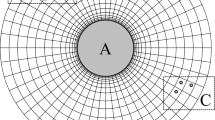With the use of decomposition into dynamic modes, reduced models of hydrodynamic mixing have been constructed and rather exact space–time pictures of impurity distribution for various periodic regimes of mixing have been obtained with substantial reduction of computational expenditures. It is shown that after processing the results of solution of the problem on mixing in a rectangular cavern with mobile bottom and lid by the DMD method, the gain in the information storage amounts to more than 80%. The proposed approach can also be applied for processing experimental data.
Similar content being viewed by others
Change history
04 March 2021
A Correction to this paper has been published: https://doi.org/10.1007/s10891-021-02295-9
References
S. K. Savel’ev and A. V. Chesnokov, Identification of flows by the local disturbance method, J. Eng. Phys. Thermophys., 90, No. 4, 1040–1043 (2017).
K. N. Volkov, S. V. Denisikhin, and V. N. Emel’yanov, Gas dynamics of a recessed nozzle on its displacement in the radial direction, J. Eng. Phys. Thermophys., 90, No. 4, 979–987 (2017).
K. G. Dobrosel’skii, Use of the PIV method for investigation of motion near a cylinder in transverse flow, J. Eng. Phys. Thermophys., 89, No. 3, 687–693 (2016).
J. L. Lumley, Stochastic Tools in Turbulence, Academic Press, New York (1970).
H. M. Раrk, O. Y. Chung, and J. H. Lee, On the solution of inverse heat transfer problem using the Karhunen–Loève Galerkin method, Int. J. Heat Mass Transf., 42, No. 1, 127–142 (1999).
O. M. Alifanov, A. V. Nenarokomov, S. A. Budnik, V. V. Michailov, and V. M. Ydin, Identification of thermal properties of materials with applications for spacecraft structures, Inv. Probl. Sci. Eng., 12, No. 5, 579–594 (2004).
B. R. Noack, K. Afanasiev, M. Morzynsk, G. Tadmor, and F. Thiele, A hierarchy of low-dimensional models for the transient and post-transient cylinder wake, J. Fluid Mech. 497, 335–363 (2003).
I. Mezić, Spectral properties of dynamical systems, model reduction and decompositions, Nonlin. Dyn., 41, Nos. 1–3, 309–325 (2005).
P. J. Schmid, Dynamic mode decomposition of numerical and experimental data, J. Fluid Mech., 656, 5–28 (2010).
P. J. Schmid, L. Li, M. P. Juniper, and O. Pust, Applications of the dynamic mode decomposition, Theor. Comput. Fluid Dyn., 25, Nos. 1–4, 249–259 (2011).
M. O. Williams, I. G. Kevrekidis, and C. W. Rowley, A data-driven approximation of the Koopman operator: Extending dynamic mode decomposition, J. Nonlin. Sci., 25, No. 6, 1307–1346 (2015).
B. W. Brunton, L. A. Johnson, J. G. Ojemann, and J. N. Kutz, Extracting spatial-temporal coherent patterns in large-scale neural recordings using dynamic mode decomposition, J. Neurosci. Methods, 258, 1–15 (2016).
J. H. Tu, C. W. Rowley, D. M. Luchtenburg, S. L. Brunton, and J. N. Kutz, On dynamic mode decomposition: Theory and applications, J. Comput. Dyn., 1, No. 2, 391–421 (2014).
C. W. Rowley, I. Mezić, S. Bagheri, P. Schlatter, and D. S. Henningson, Spectral analysis of nonlinear flows, J. Fluid Mech., 641, 115–127 (2009).
A. K. Alekseev and A. E. Bondarev, On the Application of Decomposition into Dynamic Modes in the Problems of Computational Gas Dynamics, Preprint No. 151 of M. V. Keldysh Inst. of Appl. Math., Moscow (2018).
A. K. Alekseev, D. A. Bistrian, A. E. Bondarev, and I. M. Navon, On linear and nonlinear aspects of dynamic mode decomposition, Int. J. Numer. Meth. Fluid, 82, 348–371 (2016).
R. F. Ganiev, D. L. Reviznikov, and L. E. Ukrainskii, Wave mixing, Nelin. Dinam., 4, No. 4, 483–496 (2008).
C. W. Leong and J. M. Ottino, Experiments on mixing due to chaotic advection in a cavity, J. Fluid Mech., 209, 463–499 (1989).
J. M. Ottino, The mixing of fluids, Sci. Am., 260, 56–67 (1989).
R. F. Ganiev, D. L. Reviznikov, T. Yu. Sukharev, and L. E. Ukrainskii, Wave mixing in installations of vibrational type, Probl. Mashinostr. Nadezhn. Mashin, No. 3, 5–10 (2017).
R. F. Ganiev, D. L. Reviznikov, T. Yu. Sukharev, and L. E. Ukrainskii, Optimization of spatial location of the working elements in installations of vibrational type, Probl, Mashinostr. Nadezhn. Mashin, No. 1, 3–8 (2018).
R. F. Ganiev, D. L. Reviznikov, T. Yu. Sukharev, and L. E. Ukrainskii, Influence of the shape of the blade on the efficiency of mixing in installations of vibrational type, Probl. Mashinostr. Nadezhn. Mashin, No. 2, 3–8 (2019).
R. F. Ganiev, D. L. Reviznikov, T. Yu. Sukharev, and L. E. Ukrainskii, Profiling the surfaces of the working elements of mixing devices, Probl. Mashinostr. Nadezhn. Mashin, No. 3, 3–9 (2019).
R. F. Ganiev, D. L. Reviznikov, T. Yu. Sukharev, and L. E. Ukrainskii, Wave mixing in the system of mobile coaxial cylinders, Dokl. Akad. Nauk, 486, No. 1, 30–33 (2019).
Y. Susuki, I. Mezić, F. Raak, and T. Hikihara, Applied Koopman operator theory for power systems technology, Nonlin. Theory Appl., 7, No. 4, 430–459 (2016).
Author information
Authors and Affiliations
Corresponding author
Additional information
T. Yu. Sukharev is Deceased
Translated from Inzhenerno-Fizicheskii Zhurnal, Vol. 93, No. 6, pp. 1584–1592, November–December, 2020.
Rights and permissions
About this article
Cite this article
Sukharev, T.Y., Reviznikov, D.L. Reduction of Hydrodynamic Mixing Models on the Basis of the DMD Algorithm. J Eng Phys Thermophy 93, 1529–1537 (2020). https://doi.org/10.1007/s10891-020-02257-7
Received:
Published:
Issue Date:
DOI: https://doi.org/10.1007/s10891-020-02257-7




